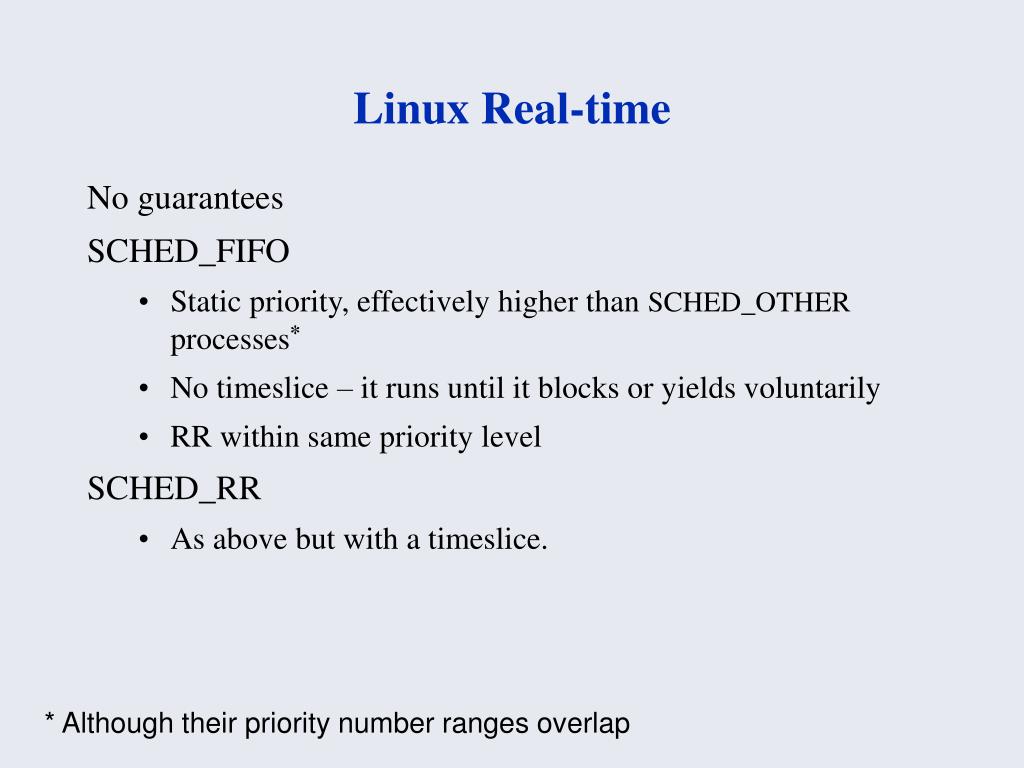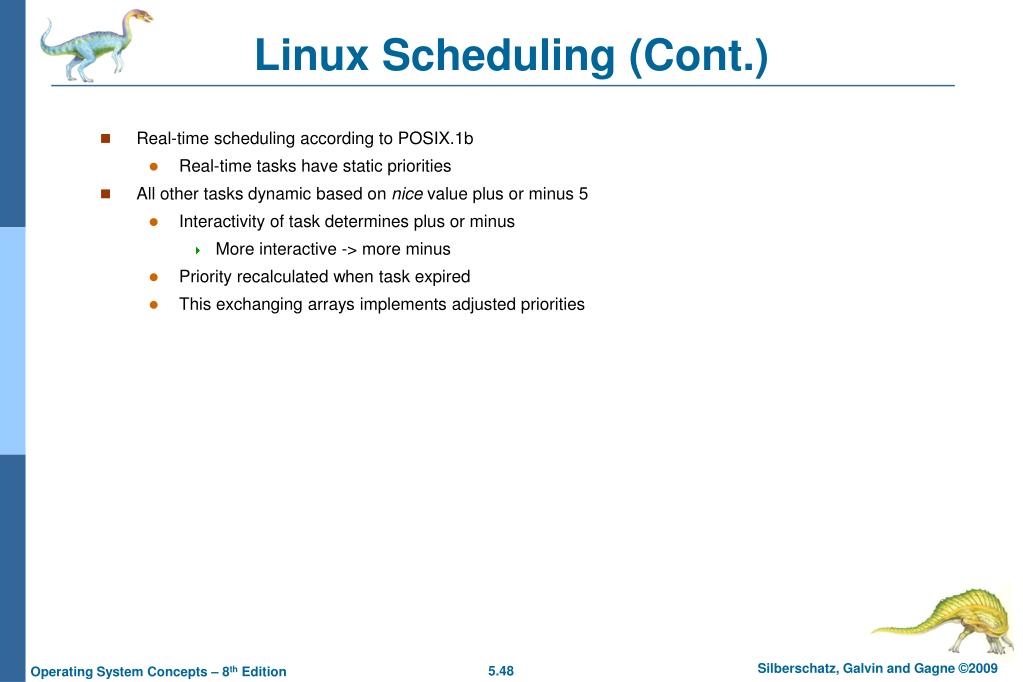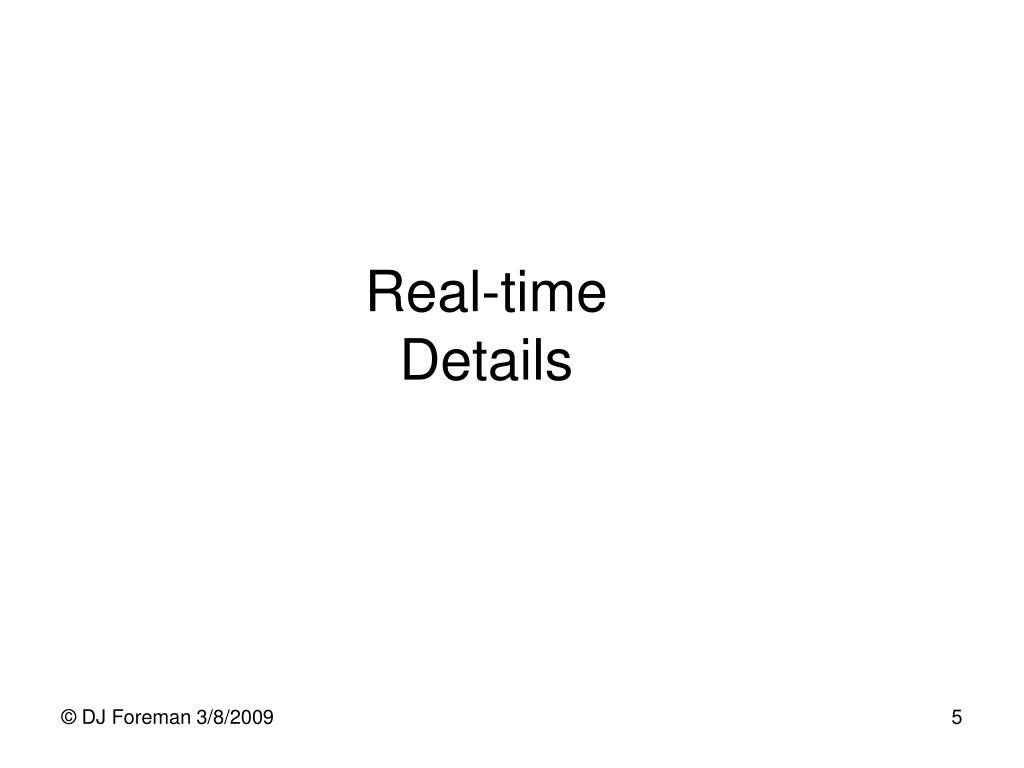
Struct cfs_rq cfs // completely fair scheduler struct rt_rq rt // real-time scheduler struct dl_rq dl // deadline scheduler This floor is called the minimum granularity. CFS imposes a floor on the timeslice assigned to each process because if number of runnable tasks approaches infinity or targeted latency is too much small, this result in unacceptable switching costs.Smaller targets yield better interactivity and a closer approximation to perfect multitasking. This target is called the targeted latency. To calculate the actual timeslice, CFS sets a target for its approximation of the "infinitely small" scheduling duration in perfect multitasking.CFS uses the nice value to weight the proportion of processor a process is to receive.So, to make similar to perfect multitasking, each process receive 1/n of the processor's time, where n is the number of runnable processes. But in our real world, processor only can run one process at a moment. This model is called perfect multitasking. In an ideal, perfectly multitasking processor, we would run both processes simultaneously, each at 50% power. The nice value acts as a weight, changing the proportion of the processor time each process receives.ĬFS is based on a simple concept : model process scheduling as if the system had an ideal, perfectly multitasking processor. Processor-bound processes crave long timeslices (to keep their cache hot).ĬFS scheduler assigns processes a proportion of the processor, therefore, the amount of processor time (timeslice) that a process receives is a function of the load of the system. I/O-bound processes do not need longer timeslices (although they do like to run often). Too short a timeslice causes significant amounts of processor time to be wasted on the overhead of switching processes. Too long a timeslice causes the system to have poor interactive performance. The timeslice (quantum) is the numeric value that represents how long a task can run until it is preempted. See detail explain about priority property rt_priority indicate real-time priority(0-99) which higher number is higher priority. In prio property(0-139), nice value is saved with real-time priority, but in this case, smaller number indicate higher priority.


In task_struct, there is no nice property alone. All real-time processes are at a higher priority than normal processes. Higher real-time priority values correspond to a greater priority. Real-time priority : default range from 0 to 99. In Linux, it is a control over the proportion of timeslice.
#Linux real time timeslice mac os#
In Mac OS X, the nice value is a control over the absolute timeslice allotted to a process.

Nice values are the standard priority range used in all Unix systems. Larger nice values correspond to a lower priority - being "nice" to the other processes on the system. Nice value : a number from -20 to +19 with a default of 0. Maximal system utilization (high throughput).Fast process response time (low latency).The scheduling policy in a system must attempt to satisfy two conflicting goals : Processor-bound processes tend to run until they are preempted because they do not block on I/O requests very often.I/O-bound process is runnable only short durations, because it eventually blocks waiting on more I/O.Then, processes can monopolize the processor for longer than the user desires. The scheduler cannot make global decisions regarding how long processes run. The act of a process voluntarily suspending itself is called yeilding. In cooperative multitasking, a process does not stop running until it voluntary decides to do so. Timeslice : The time a process runs before it is preempted. The act of involuntarily suspending a running process is called preemption. In preemptive multitasking, the scheduler decides when a process is to cease running and a new process is to begin running. By deciding which process runs next, the scheduler is responsible for best utilizing the system and giving users the impression that multiple processes are executing simultaneously. The process scheduler decides which process runs, when, and for how long.



 0 kommentar(er)
0 kommentar(er)
